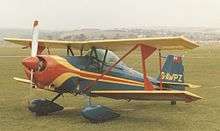Andreasson BA-4B
The Andreasson BA-4B is a single-seat aerobatic biplane which was marketed for homebuilding and also produced complete.
| BA-4B | |
|---|---|
 | |
| Role | Sports biplane |
| Manufacturer | Homebuilt |
| Designer | Björn Andreasson |
| First flight | 1966 |
| Developed from | Andreasson BA-4 |
| Developed into | Andreasson BA-11 |
Design and development


The BA-B4B was based on Andreasson's 1944 wooden BA-4 revised to take advantage of more modern construction techniques, such as the use of sheet metal. The first example was built by apprentices at the Malmö Aircraft Industry (M.F.I.).[1] It is a single-bay, staggered-wing biplane with fixed tailwheel undercarriage. P.J.C Phillips acquired worldwide production rights for complete, rather than kit built, version and marketed them in the UK through Crosby Aviation.[2] In the US the B-4B was marketed by Larry Karp as the Canary Hawk.
Operational history
In 2014 there were six BA-4Bs on the UK civil register, one Crosby built and the others homebuilt. Three of these have the Continental O-200-A engine but the other three use Lycoming flat fours with outputs between 81 kW (108 hp) and 119 kW (160 hp).[3] In 2009 four BA-4Bs remained on the Swedish register.[4]
Variants

- Andeasson B-4 (Midget)
- Wood and fabric biplane first flown in 1944, powered by a 21 kW (28 hp) Scott Squirrel.[1]
- Andreasson B-4B
- All-metal version. First prototype built by M.F.I apprentices in c.1964. Plans marketed.[5]
- Crosby (Andreasson) B-4B
- Sold complete, powered by a 75 kW (100 hp) Rolls-Royce Continental O-200-A flat four.[2]
- Crosby (Andreasson) Super B-4B
- As B-4B but with a 89 kW (120 hp) Rolls-Royce Continental O-240-A flat four.[2]
Specifications (Crosby (Andreasson) BA-4B)
Data from Jane's All the World's Aircraft 1974/5[2]
General characteristics
- Crew: One
- Length: 4.67 m (15 ft 4 in)
- Wingspan: 5.64 m (18 ft 6 in)
- Wing area: 8.36 m2 (90.0 sq ft)
- Empty weight: 295 kg (650 lb)
- Max takeoff weight: 460 kg (1,014 lb)
- Fuel capacity: 56.3 l (12.4 imp gal; 14.9 US gal) internal. Provision for external tank holding extra 50 l (11.0 imp gal; 13.2 US gal)
- Powerplant: 1 × Rolls-Royce Continental O-200-A flat four, 75 kW (100 hp)
- Propellers: 2
Performance
- Maximum speed: 241 km/h (150 mph, 130 kn) level flight, sea level
- Cruise speed: 217 km/h (135 mph, 117 kn) 75% power at 2,134 m (7,000 ft)
- Stall speed: 73 km/h (45 mph, 39 kn) power on
- Range: 573 km (356 mi, 309 nmi) standard fuel, 75% power
- Rate of climb: 6.1 m/s (1,200 ft/min) maximum at sea level
- Wing loading: 54.7 kg/m2 (11.2 lb/sq ft)
References
| Wikimedia Commons has media related to Andreasson BA-4. |
Notes
- Airlife's World Aircraft p.44
- Jane's All the World's Aircraft 1974/5 p.205
- http://www.caa.co.uk
- Partington
- Jane's All the World's Aircraft 1974/5 p.181
Bibliography
- Taylor, John W R (1974). Jane's All the World's Aircraft 1974–75. London: Jane's Yearbooks. pp. 181, 205. ISBN 0 354 00502 2.
- Taylor, Michael J. H. (1989). Jane's Encyclopedia of Aviation. London: Studio Editions. p. 60.
- Partington, Dave (2010). European registers handbook 2010. Air Britain (Historians) Ltd. ISBN 978-0-85130-425-0.